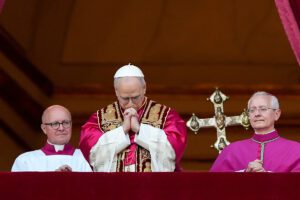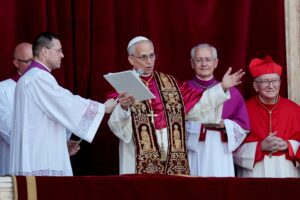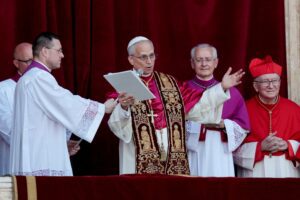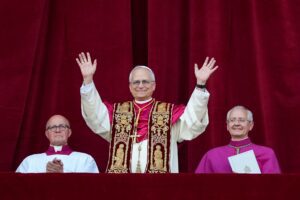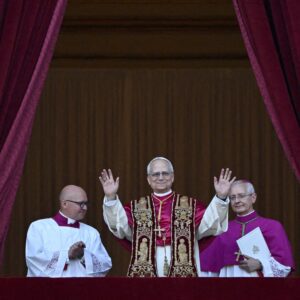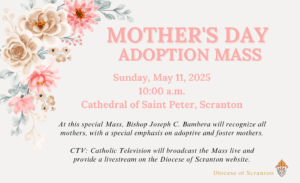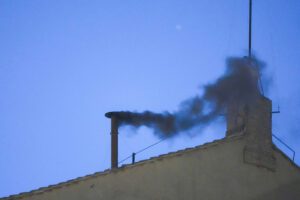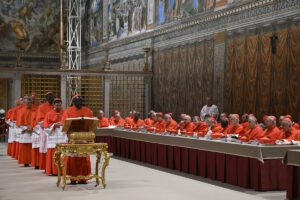WASHINGTON (OSV News) – President Donald Trump on May 8 congratulated Cardinal Robert F. Prevost, the Chicago-born prefect of the Dicastery for Bishops under Pope Francis, who was elected the 267th pope the same day, taking the name Pope Leo XIV.
In a post on his social media website Truth Social, Trump noted Pope Leo will be the first American pontiff in the church’s history.
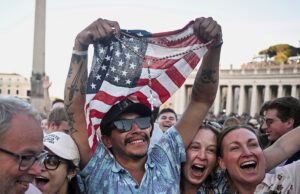
“Congratulations to Cardinal Robert Francis Prevost, who was just named Pope,” Trump wrote. “It is such an honor to realize that he is the first American Pope. What excitement, and what a Great Honor for our Country.”
Trump added, “I look forward to meeting Pope Leo XIV. It will be a very meaningful moment!”
Trump, who attended the funeral Mass for the late Pope Francis on April 26, had also stirred some controversy during the official days of mourning for the late pontiff by posting an image depicting himself as pope. The image, apparently generated by artificial intelligence, was also posted to the White House’s social media account.
In comments to reporters at the White House, Trump said, “It’s such a great honor for our country, an American pope, and what greater honor can there be.”
Trump called himself “a little bit surprised” at Pope Leo’s election, but repeated it was an “absolutely great honor.”
Former President Joe Biden, the second Catholic to hold that office, wrote on X, “Habemus papam – May God bless Pope Leo XIV of Illinois.”
“Jill and I congratulate him and wish him success,” Biden said.
Former President Barack Obama said on X that he and former first lady Michelle Obama “send our congratulations to a fellow Chicagoan, His Holiness Pope Leo XIV.”
“This is a historic day for the United States, and we will pray for him as he begins the sacred work of leading the Catholic Church and setting an example for so many, regardless of faith,” Obama said.
Former President George W. Bush said in a statement that he and former first lady Laura Bush “are delighted to congratulate former Cardinal Robert Prevost on his election to the papacy.”
“This an historic and hopeful moment for Catholics in America and for the faithful around the world,” Bush said. “We join those praying for the success of Pope Leo XIV as he prepares to lead the Catholic church, serve the neediest, and share God’s love.”
Vice President JD Vance, the second Catholic to hold that office, wrote on X, “Congratulations to Leo XIV, the first American Pope, on his election!”
“I’m sure millions of American Catholics and other Christians will pray for his successful work leading the Church. May God bless him!” said Vance, who met with Pope Francis on Easter, the day before the late pontiff’s death April 21.
The U.S.-born Pope Leo comes into the papacy at a time when the U.S. church has faced significant challenges with respect to the Trump administration’s policies on migration and refugees. However, Catholic Relief Services’ president and CEO Sean Callahan described Pope Leo as a leader who is “voice for the voiceless and a fierce supporter of human dignity for all people.”
In social media posts prior to becoming pontiff, then-Cardinal Prevost shared posts on X critical of the Trump administration’s immigration policy. In February, he shared an opinion piece from the National Catholic Reporter titled “JD Vance is wrong: Jesus doesn’t ask us to rank our love for others,” a reference to the vice president’s comments about the Catholic theological concept of the “ordo amoris” (the order of love or charity) — a subject that Pope Francis decided to address directly, without naming Vance, in a public address to the U.S. bishops.
Catholic lawmakers from both parties also congratulated the new Pope Leo.
House Speaker Emerita Nancy Pelosi, D-Calif., wrote on X, “Joyfully, people around the world have learned of a new Pope elected by one of the largest and most diverse conclaves ever – and the first American pope in history.”
“For many of us, the name Leo XIV happily brings to mind Leo XIII’s Rerum novarum which was a blessing for working people,” Pelosi added. “And it is heartening that His Holiness continued the blessing that Pope Francis gave on Easter Sunday: “God loves everyone. Evil will not prevail.”
“Rerum Novarum” (on capital and labor) is an 1891 encyclical by Pope Leo XIII. It is considered the starting point of modern social teaching by the popes.
Pelosi also quoted previous comments from the new pope: “We can be a missionary church, a church that builds bridges, that is always open to receive everyone.”
“Let us thank God for His Holiness Pope Leo XIV and for this vision of unity,” she said. “All of us hope and pray for the success of His Holiness and his vision for the Church.”
Sen. Susan Collins, R-Maine, wrote on X, “Blessings to Pope Leo XIV, our first American Pope, on his selection to serve as the Bishop of Rome.”
“May he receive guidance from Jesus Christ our Lord and inspire the global community of Catholics and all people by sharing the message of God’s unconditional love,” she said.
Lawmakers of other faith traditions also congratulated the new pope.
House Speaker Mike Johnson, R-La., wrote on X, “May God bless the first American papacy in these historic days.”
Rep. Robin Kelly, D-Ill., wrote on X that Pope Leo grew up in Dolton, Illinois, within the district she represents.
“I wish Pope Leo XIV wisdom and integrity as he leads the Church toward greater inclusion, stronger faith, and love for all,” she wrote.
Gov. JB Pritzker, D-Ill., also noted Pope Leo’s ties to the Prairie State in a post on X.
“A historic moment as we witness the first American leading the Catholic Church,” he wrote. “Hailing from Chicago, Pope Leo XIV ushers in a new chapter that I join those in our state welcoming in at a time when we need compassion, unity, and peace.”
Former House Speaker John Boehner, a Catholic Republican who was in office when the late Pope Francis delivered his historic 2015 address to a joint session of Congress, wrote on X that while that moment “was a big deal,” he said, “This is seismic.”
“May God Bless Pope Leo XIV, and through him, bring His light to the world,” Boehner said.

